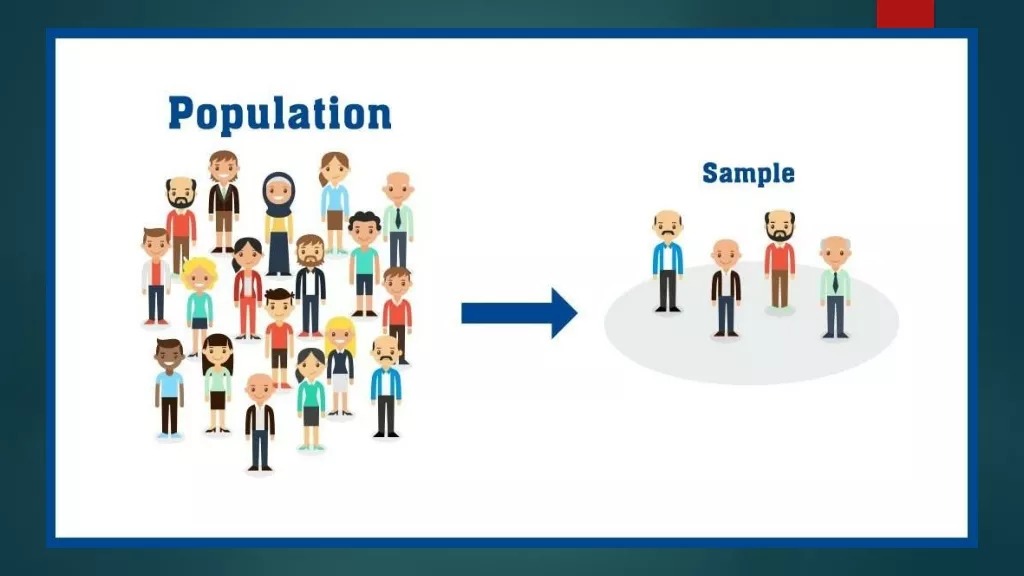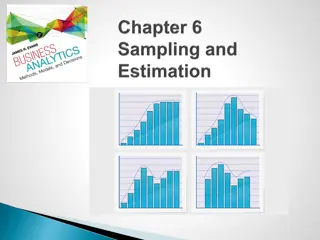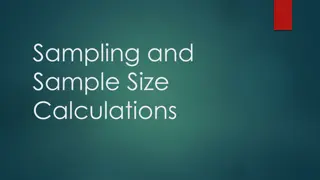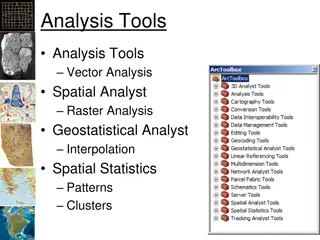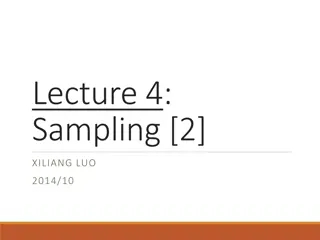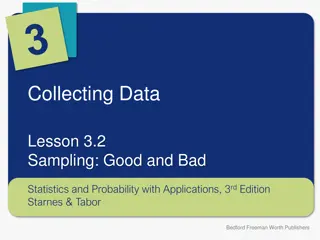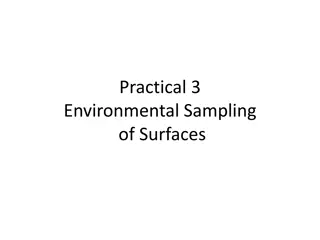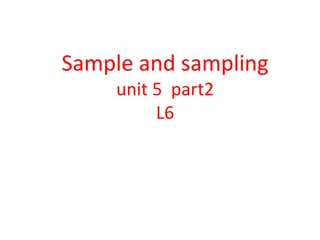Sampling Methods in Statistical Analysis
Sampling is a crucial process in statistical analysis where observations are taken from a larger population. Different sampling techniques are used based on the analysis being performed. Sampling methods help in studying populations when studying the entire population is not feasible. There are two
4 views • 8 slides
Sampling Under the RRF - General Principles and Methods
Sampling under the RRF is essential for the Commission to ensure reasonable assurance of fulfillment of numerical milestones or targets. The approach involves statistical risk-based random sampling with specific thresholds and considerations for different types of milestones. Various statistical tab
1 views • 12 slides
Non-Probability Sampling Methods
Non-probability sampling methods involve selecting samples based on subjective judgment rather than random selection. Types include convenience sampling, quota sampling, judgmental (purposive) sampling, and snowball sampling. Convenience sampling picks easily available samples, quota sampling select
5 views • 7 slides
Spatial Database Systems: An Overview
This presentation by Xiaozhi Yu introduces the fundamentals of spatial database systems, covering topics such as spatial data types, relationships, system architecture, modeling, and organizing underlying spaces. It delves into the importance of integrating geometry into DBMS data models, spatial in
8 views • 30 slides
Systematic Analysis of Real Samples in Analytical Chemistry
This analysis covers the systematic process involved in analyzing real samples, including sampling, sample preservation, and sample preparation. It discusses the importance of accurate sampling in obtaining information about various substances, such as solids, liquids, gases, and biological material
0 views • 54 slides
Sampling Plans in Statistical Analysis
Sampling is vital for statistical analysis, with sampling plans detailing objectives, target populations, operational procedures, and statistical tools. Different sampling methods like judgmental, convenience, and probabilistic sampling are used to select samples. Estimation involves assessing unkno
2 views • 36 slides
Sampling Methods and Errors in Research
Sampling is crucial in research to draw conclusions about a population. Various methods like simple random sampling, stratified sampling, and systematic sampling help in selecting representative samples. Sampling error arises due to differences between sample and population values, while bias leads
9 views • 12 slides
Fundamentals of Food Sampling and Analysis
Discover the key methods and procedures for sampling, transportation, and storage of environmental parameters, focusing on food sampling and analysis. Explore the importance of representative samples, quality analysis results, and risks associated with sampling. Learn about homogeneous vs. heterogen
20 views • 36 slides
GIS Data Models for Spatial Planning Training in Maputo, Mozambique
Explore the concepts of GIS data models including vector vs. raster, spatial relationships, spatial operations, and representation of real-world entities in a spatial database. Understand how spatial data models are used to manipulate spatially-referenced information and define the spatial location
3 views • 32 slides
Spatial Autocorrelation in Geostatistical Analysis
Explore the concept of spatial autocorrelation, its implications in geostatistical analysis, and the importance of detecting and interpreting it correctly. Learn about auto-correlation, signal components, correlation significance, and measuring autocorrelation using tools like Moran's I. Gain insigh
7 views • 12 slides
Sampling and Signal Processing Fundamentals
Sampling plays a crucial role in converting continuous-time signals into discrete-time signals for processing. This lecture covers periodic sampling, ideal sampling, Fourier transforms, Nyquist-Shannon sampling, and the processing of band-limited signals. It delves into the relationship between peri
6 views • 60 slides
Biases in Sampling Methods
Statistical studies rely on samples to draw conclusions about populations, but the method of sampling can introduce biases. This text discusses convenience sampling, voluntary response sampling, random sampling, and the implications of biased sampling methods on study results. It highlights how bias
2 views • 12 slides
Guide to Environmental Surface Sampling Techniques
Understanding the importance of environmental surface sampling is crucial for ensuring hygiene and safety. This guide covers key aspects such as pre-sampling considerations, aseptic techniques, major sampling methods like RODAC plate, swab, and wipe methods, along with detailed procedures for each m
4 views • 16 slides
Lead Dust Wipe Sampling Techniques and Guidelines
This resource provides valuable information on lead dust wipe sampling techniques for Lead Dust Sampling Technicians. It covers the objectives, measuring lead dust, sampling strategy, sampling locations based on EPA RRP Rule, and HUD clearance regulations. Techniques for taking dust wipe samples, id
6 views • 41 slides
Comprehensive Guidelines for Meth Residue Sampling by Local Health Departments
This detailed guide outlines the procedures and protocols for meth residue sampling conducted by local health departments. It covers the reasons for sampling, the importance of qualified inspectors, testing methodologies, sampling kits assembly, and more. Key points include when and why sampling is
5 views • 19 slides
Sampling in Social Research Methods
Sampling in social research involves selecting a portion of a population to draw conclusions about the entire group. It helps save time, money, and allows for accurate measurements. The key principles of sampling include systematic selection, clear definition of sample units, independence of units,
4 views • 19 slides
Non-Probability Sampling Methods
Non-probability sampling involves selecting samples based on subjective judgment rather than random selection, leading to a lack of equal chances for all population members to participate. Various types include convenience sampling, quota sampling, judgmental sampling, and snowball sampling. Conveni
4 views • 7 slides
Approximate Inference in Bayes Nets: Random vs. Rejection Sampling
Approximate inference methods in Bayes nets, such as random and rejection sampling, utilize Monte Carlo algorithms for stochastic sampling to estimate complex probabilities. Random sampling involves sampling in topological order, while rejection sampling generates samples from hard-to-sample distrib
3 views • 9 slides
State Crime Lab Drug Sampling Protocols
Using the State Crime Lab's drug sampling protocols for defense involves understanding three sampling methods: administrative sample selection, threshold sample selection, and hypergeometric sampling plan. The hypergeometric plan allows experts to make assumptions about the chemical composition of u
3 views • 30 slides
Non-Probability Sampling Methods
Non-probability sampling involves selecting samples based on subjective judgement rather than random selection. This method may not give all population members an equal chance to participate. Types include convenience sampling, quota sampling, judgemental sampling, and snowball sampling.
2 views • 7 slides
Non-Probability Sampling Techniques in Nursing Research
Non-probability sampling in nursing research involves selecting samples subjectively rather than randomly. This sampling method carries a higher risk of bias and limits statistical inference about the entire population. Five main types include convenience, purposive, quota, snowball, and voluntary r
7 views • 30 slides
Sampling: Importance, Process, and Errors Explained
This content delves into the world of sampling, exploring why sampling is crucial, the sampling process involving defining populations and calculating sample sizes, and the distinction between non-sampling and sampling errors. It covers the significance of representative samples, common errors in sa
3 views • 15 slides
Sampling and Surveys: Understanding Population and Sample
In statistics, understanding the population and sample is crucial. Learn about different sampling methods, such as voluntary response and convenience sampling, and how they can introduce bias. Explore techniques like simple random sampling, stratified random sampling, and cluster sampling. Discover
4 views • 54 slides
Characteristics of Sampling Methods in Social Networks
Demystify sampling methods in social networks through various techniques like random walks, uniform vertex sampling, and edge sampling. Explore how these methods help in evaluating network structures accurately and efficiently across different platforms. Understand the pros and cons of uniform edge
2 views • 26 slides
Overview of Sampling Methods in Markov Chain Monte Carlo
This content covers various sampling methods in Markov Chain Monte Carlo including Rejection Sampling, Importance Sampling, and MCMC Sampling. It delves into representing distributions, drawbacks of Importance Sampling, and the motivation behind Markov Chain Monte Carlo Sampling. The illustrations p
0 views • 25 slides
Sampling Technique For Quantitative Data Presentation
This presentation focuses on sampling techniques for quantitative data collection in research studies. It covers concepts such as population, sample, sampling frame, types of sampling, and non-probability sampling methods. Dr. Aniket Shukla presents the importance of rigorous sampling plans to avoid
5 views • 17 slides
Geostatistical Distances Analysis in Spatial Studies
Geostatistics, a branch of statistics focusing on spatial datasets, plays a crucial role in various disciplines like geology, hydrology, and agriculture. Tobler's First Law of Geography forms the foundation of spatial analysis, emphasizing the relationship between proximity and interaction in spatia
2 views • 6 slides
Fundamental Sampling Distributions and Random Sampling in Statistical Analysis
In statistical analysis, understanding fundamental sampling distributions and random sampling is crucial for making accurate inferences about populations. Sampling involves selecting a subset from a population to draw conclusions when observing the entire population is impractical. Random sampling h
2 views • 23 slides
Digital vs Analog Signal Conversion: Sampling, Quantizing, Coding
Discover the process of converting analog signals to digital using techniques like sampling, quantizing, and coding. Learn how sampling ensures accurate representation of analog signals in the digital realm, adhering to the sampling theorem for optimal signal reconstruction. Explore various sampling
1 views • 26 slides
Industrial Engineering Sampling Methods Overview
Learn about different sampling methods used in industrial engineering, including probability sampling (such as simple random sampling, stratified sampling, cluster sampling) and non-probability sampling (like volunteer and judgmental sampling). Understand the principles behind simple random sampling
5 views • 17 slides
Sampling Techniques for Quantitative Data in Health Research
This presentation discusses sampling techniques for quantitative data in health research, covering topics such as sample representativeness, sample frame, and types of sampling methods. It explains the importance of having a rigorous sampling plan to avoid biased estimates in research studies. The d
2 views • 17 slides
Sampling Methods for Population Studies
Learn about the challenges of studying entire populations and how sampling methods such as random and non-random sampling help generalize findings effectively. Explore probability and non-probability sampling techniques, including simple random sampling and systematic random sampling.
4 views • 13 slides
Sampling Methods in Statistics and Research
Learn about the different types of sampling methods in statistics and research, including purposive sampling, random sampling, stratified sampling, and more. Explore how sampling techniques are used to estimate characteristics of a population, with examples and explanations provided.
4 views • 11 slides
Sampling Methods in Statistical Analysis
Sampling is a crucial process in statistical analysis where observations are taken from a larger population to draw valid conclusions. Understanding the population, sample, and sampling frame is essential in research to ensure representativeness and validity of results. Defining the target populatio
0 views • 9 slides
Understanding Sampling Techniques in Research Studies
Learn about different types of sampling methods including non-probability and probability sampling techniques such as simple random sample, systematic random sample, stratified random sampling, and cluster sampling. Explore why sampling is crucial in research, and how it helps in saving time and cos
0 views • 8 slides
Sampling Methods in Statistics and Probability
Explore the importance of sampling methods in statistical studies, focusing on convenience sampling, voluntary response sampling, and random sampling. Understand how each method can lead to bias and learn how random sampling helps avoid bias in collecting data to make accurate conclusions about popu
1 views • 8 slides
Efficient Sampling Methods in Statistics
Explore various sampling methods in statistics like simple random sampling, systematic sampling, probability vs. non-probability sampling, and techniques to determine sample size using Cochran's and Yamani's formulas. Learn how to implement sampling in R for data analysis.
0 views • 21 slides
Understanding Sampling Methods and Biases in Statistics
Learn about representative populations, different types of sampling biases, and various sampling methods like judgmental sampling, voluntary sampling, and stratified random sampling. Discover how biases can impact the accuracy of research outcomes and understand the importance of selecting samples i
1 views • 17 slides
Understanding Spatial Data Mining
Learn about spatial data mining, a process of uncovering interesting, useful, and unexpected spatial patterns within large databases. Discover why it is essential for gaining new insights into geographic processes and application domains, such as locating human settlements, identifying cancer cluste
2 views • 37 slides
Understanding Non-Probability Sampling Methods
Explore the world of non-probability sampling techniques, including convenience sampling, quota sampling, judgemental sampling, and snowball sampling. Learn how researchers select samples based on subjective judgement rather than random selection, impacting data collection and analysis.
1 views • 7 slides
